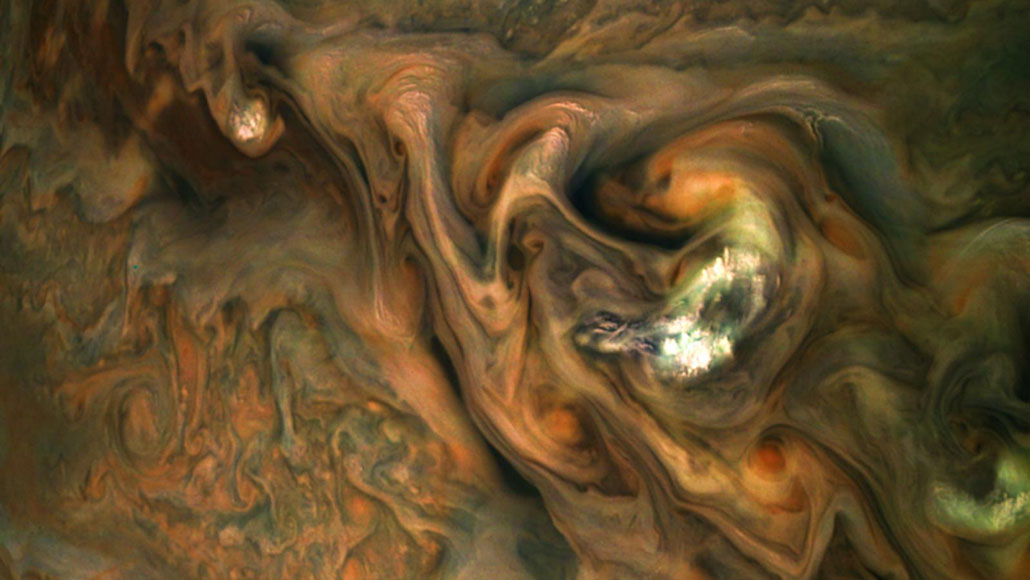alien: A non-native organism. (in astronomy) Life on or from a distant world.
ammonia: A colorless gas with a nasty smell. Ammonia is a compound made from the elements nitrogen and hydrogen. It is used to make food and applied to farm fields as a fertilizer. Secreted by the kidneys, ammonia gives urine its characteristic odor. The chemical also occurs in the atmosphere and throughout the universe.
astronomer: A scientist who works in the field of research that deals with celestial objects, space and the physical universe.
atmosphere: The envelope of gases surrounding Earth or another planet.
chemical: A substance formed from two or more atoms that unite (bond) in a fixed proportion and structure. For example, water is a chemical made when two hydrogen atoms bond to one oxygen atom. Its chemical formula is H2O. Chemical also can be an adjective to describe properties of materials that are the result of various reactions between different compounds.
climate: The weather conditions that typically exist in one area, in general, or over a long period.
cloud: A plume of molecules or particles, such as water droplets, that move under the action of an outside force, such as wind, radiation or water currents. (in atmospheric science) A mass of airborne water droplets and ice crystals that travel as a plume, usually high in Earth’s atmosphere. Its movement is driven by winds.
colleague: Someone who works with another; a co-worker or team member.
develop: To emerge or to make come into being, either naturally or through human intervention, such as by manufacturing.
drizzle: Light mist-like precipitation caused by water droplets smaller than those due to rain, meaning usually much smaller than 1 millimeter (0.04 inch) in diameter.
element: A building block of some larger structure. (in chemistry) Each of more than one hundred substances for which the smallest unit of each is a single atom. Examples include hydrogen, oxygen, carbon, lithium and uranium.
equation: In mathematics, the statement that two quantities are equal. In geometry, equations are often used to determine the shape of a curve or surface.
fluid mechanics: The study of the properties of fluids (liquids and gases) and their reactions to the forces acting upon them under various conditions.
gas giant: A giant planet that is made mostly of the gases helium and hydrogen. Jupiter and Saturn are gas giants.
host: (v.) The act of providing a home or environment for something.
Jupiter: (in astronomy) The solar system’s largest planet, it has the shortest day length (10 hours). A gas giant, its low density indicates that this planet is composed of light elements, such as hydrogen and helium. This planet also releases more heat than it receives from the sun as gravity compresses its mass (and slowly shrinks the planet).
liquid: A material that flows freely but keeps a constant volume, like water or oil.
Mars: The fourth planet from the sun, just one planet out from Earth. Like Earth, it has seasons and moisture. But its diameter is only about half as big as Earth’s.
mass: A number that shows how much an object resists speeding up and slowing down — basically a measure of how much matter that object is made from.
mechanics: The study of how things move.
Milky Way: The galaxy in which Earth’s solar system resides.
moisture: Small amounts of water present in the air, as vapor. It can also be present as a liquid, such as water droplets condensed on the inside of a window, or dampness present in clothing or soil.
moon: The natural satellite of any planet.
observatory: (in astronomy) The building or structure (such as a satellite) that houses one or more telescopes.
physics: The scientific study of the nature and properties of matter and energy. Classical physics is an explanation of the nature and properties of matter and energy that relies on descriptions such as Newton’s laws of motion. Quantum physics, a field of study that emerged later, is a more accurate way of explaining the motions and behavior of matter. A scientist who works in such areas is known as a physicist.
planet: A large celestial object that orbits a star but unlike a star does not generate any visible light.
precipitation: (in meteorology) A term for water falling from the sky. It can be in any form, from rain and sleet to snow or hail.
radius: A straight line from the center to the circumference of a circle or sphere.
range: The full extent or distribution of something. For instance, a plant or animal’s range is the area over which it naturally exists.
surface area: The area of some material’s surface. In general, smaller materials and ones with rougher or more convoluted surfaces have a greater exterior surface area — per unit mass — than larger items or ones with smoother exteriors. That becomes important when chemical, biological or physical processes occur on a surface.
thermodynamics: A branch of physics or physical chemistry that describes how energy can transfer from one place to another of convert from one form to another. It deals with relationships between work, temperature and energy (be it chemical, electrical or mechanical energy). For instance, heat is one form of energy and it relates to a definable quantity of mechanical work.
titan: The term for any gigantic being. The term comes from Greek mythology. The six sons and six daughters of the Greek gods Uranus and Gaea were known as titans. Capitalized Titan is a moon of Saturn.
unique: Something that is unlike anything else; the only one of its kind.
water vapor: Water in its gaseous state, capable of being suspended in the air.








